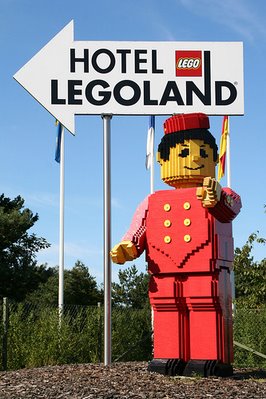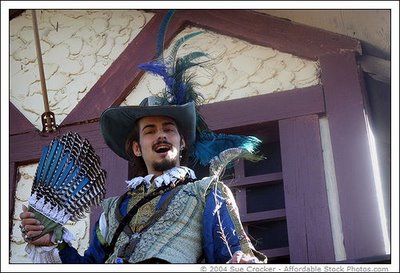Wednesday, December 20, 2006
Random Flickr Blogging #9684; or, Random Carl Sagan Memorial Flickr Blogging
Bruce Springsteen once spoke of the snare drum shot that opens Bob Dylan's "Like a Rolling Stone" as sounding "like somebody had kicked open the door to your mind." I was delighted when I first encountered Springsteen's simile, as for some time I've used a similar simile to describe the effect of watching Monty Python's Flying Circus when it first ran in America on PBS back in the 1970s. For example, I still remember the first time I saw "The News for Parrots" sketch. It's a relatively simple idea on paper: imagine a typical nightly newscast, only slanted toward the interests of parrots. We see typical human newsy events: an automobile accident; a meeting of governmental ministers. However, the focus is on the parrotesque: no parrots were involved in the car crash; none of the important ministers went in the cage, or swung on the little trapeze, or ate any of the nice millet seed, yum yum. This is a nifty little collision of frameworks in its own right, but I still think that what comes next is one of the funniest things I have ever see in forty-mumblth years on this planet. The news ends, and now it's time for the program for parrots: Part Three of A Tale of Two Cities, specially adapted for parrots by "Joey-boy." The news reader (the oh-so-sincere Michael Palin) recounts the story so far: Dr. Manette spent 18 years in the Bastille, Lucy loves Charles Darnay, etc. We see a caption: "London 1793." The camera fades in on a thoroughly believable period scene, period costumes—that Hazel Pethig did more for the Pythons' art than many of us realize, I fear. Graham Chapman enters as Darnay, all dour and Dickensian, and stands somberly at the foot of the ailing Dr. Manette's bed. The scene is silent and serious for a second. Then, Chapman turns and squawks, in his best parrot voice, "'ello! 'ello!" Carol Cleveland as Lucy answers: "'ello! 'ello!" Dr. Manette (Terry Jones) offers similar greetings. Chapman responds with "oo's a pretty boy, then?" In moments, the somber Dickensian scene has devolved into hysterical wide-eyed squawking and screeching. The whole sketch is over in seconds, but what seconds.
I still remember literally rolling on the floor, laughing uncontrollably, the first time I saw this sketch. It wasn't just that it was funny (the synopsis above cannot do it justice); I was also laughing because, as I watched, I could feel the Pythons kicking doors open in my mind—and I liked that very much. It had not occurred to me that you could do such things to Dickens, to PBS melodramas, to the TV news; it had not occurred to me that you could slam things like these and parrots and silly walks and ministries and archaeology and Westerns and musicals and upper-class twits and Hitler (sorry, Hilter) and election night specials and cannibalism and undertakers and Jean-Paul Sartre and all sorts of other things together in all sorts of wacky ways—and derive enjoyment from the odd collisions and connections. I.A. Richards once said, "The mind is a connecting organ; it works only by connecting and it can connect any two things in an indefinitely large number of different ways." The Pythons often made me roar with laughter (and they still do) because what they did was funny, but they also made me roar with laughter because they were waking me up to the awesome connective power of the human mind—including my human mind. That's some of what I remember feeling as I rolled on the floor laughing at how the Pythons had bodied forth the odd conceit of a Dickens masterwork adapted for bird brains: look at what these mind things can do with reality when we really let 'em rip. The Pythons taught us lesson after lesson in this power, and for that I could never thank them enough.
Carl Sagan's Cosmos series did something similar for me when I first saw it, too, on PBS back in the 1970s. (It's depressing, isn't it, to think that once upon a time PBS regularly brought us things like Monty Python's Flying Circus and Cosmos? Nowadays it seems like whenever I turn it on down here, all I see is Andre Rieu or Celtic Softcore—um, I mean Celtic Woman.) Cosmos is the first place where I remember having hammered home to me, through Sagan's canny connection of imagery, music, and information, the idea that those things that I studied as separate subjects in the ordeal called school—math and biology and physics and chemistry and history and literature and so on—weren't really separate at all but integral parts of a grand, grand adventure: the human quest to understand the universe and our place within it. Cosmos helped me see the connection between the stuff I was learning about in school and the great path of wonder and inquiry stretching back centuries and walked by the likes of Socrates, Leonardo, Shakespeare, and Einstein. Cosmos made me realize that that path was part of my birthright as a human being—it's a great legacy that belongs to all of us—and that I could walk it, too, and in fact already was as in my own small way as I learned in school about things like the Pythagorean theorem and atomic theory and the scientific and Socratic methods. I had always been a nerdy, brainy kid who "liked school"—at least the parts of it that involved actual learning—but Carl Sagan and Cosmos helped me to see education as something, dare I say, sacred and liberating and glorious. Carl Sagan helped me to realize that that sense of wonder I felt about the world and my place in it was not something weird and alien but rather something that connected me to a great tradition stretching back through the great artists, scientists, and philosophers of the human past—and forward into the human future in which I would share. In his way, Carl Sagan helped me to appreciate the power of the human mind, too, and for that I could never thank him enough, either.
But here we are, ten years after his death, and there's Random Flickr Blogging to be done, so let me offer some thanks to Carl Sagan in my own small, strange way. One of my favorite odd facts about Sagan is that he chaired the committee that compiled the Golden Records sent out with the Voyager probes in 1977. These contain a selection of images from Earth, greetings from Earth in a plethora of languages, and of course a delightful selection of Earth music, from aboriginal chants to Bach to Peruvian panpipes to Chuck Berry. The hope is that someday, should Voyager 1 or 2 ever be encountered by another intelligent species somewhere out there in the cosmos, the Golden Records will give their finders some idea of Who We Are. I cannot imagine what the process of collection and selection for these records must have been like—how do you sum up humanity in a few dozen sounds, songs, and images?—but for this week's Random Flickr Blogging, I thought I'd try imagining what might happen if you put some random Flickr photos through the process.
Carl Sagan, you gave me and thousands of others a gift that we could never repay; we can only try to pass it on in our own various ways. Thank you for helping to enlighten us, and for stretching our minds, and for reminding us that our sense of wonder is one of the best things we have. Thank you for sharing your own sense of wonder with us in works written for us—and not just for a tiny audience of fellow scientists. Thank you for all you did to help kindle my sense of wonder all those years ago. Thank you for helping to kick open those doors in my mind that have never closed. Thank you.






Random Flickr Blogging explained here; photos from here, here, here, here, here, here, and here.
Labels: Random Flickr Blogging
I will never forget a certain Easter Sunday afternoon, sitting on the roof of a bar in Tijuana drinking way too much tequila and writing haikus with you and amycamus, and feeling like we were perhaps the funniest and most creative individuals on the planet at that particular moment. This particular RFB is inspired in the way the Dickens-for-parrots sketch was inspired. Hurray for Carl Sagan, and hurray for you.
Also, just a heads-up: Tom Hilton named me in a literary game of blog-tag, and I plan on passing it along to you (now that I've buttered you up [I hope] sufficently). I haven't posted it yet, so you still have some time, but you might want to check my site fairly soon. I think it will be something you'll enjoy.
Nice job, Nash!
<< Home


